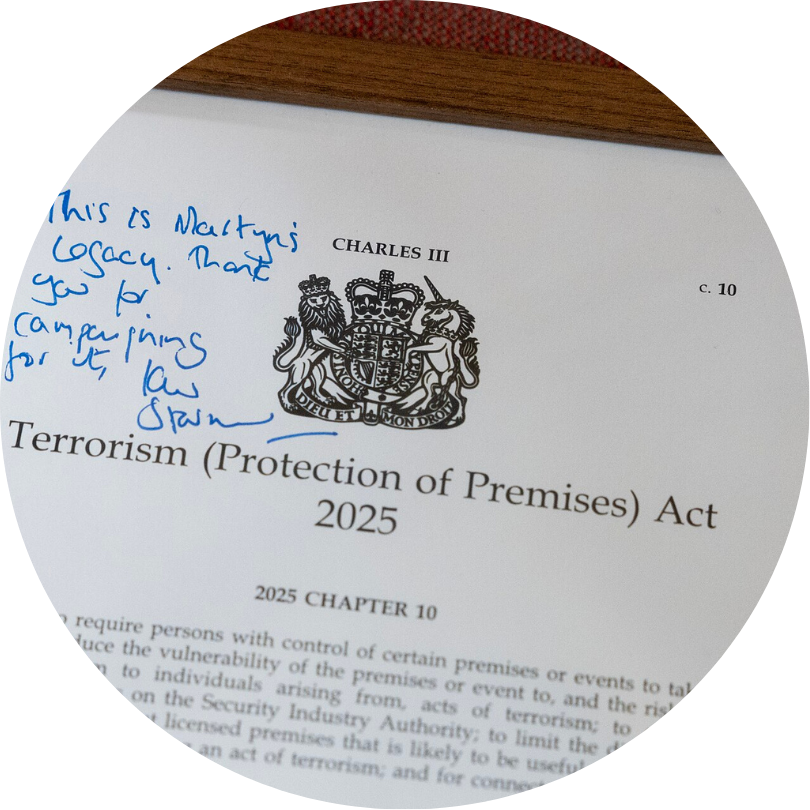Martyn’s Law: Enhancing Public Safety
Comprehensive guide to the Terrorism (Protection of Premises) Act 2025

What Is Martyn’s Law?
Martyn’s Law, officially called the Terrorism (Protection of Premises) Act 2025, was introduced following the tragic Manchester Arena bombing in 2017, in which 22 people lost their lives, including Martyn Hett. The law aims to ensure publicly accessible venues are better prepared to deal with the risk of terrorism and attacks.
The legislation applies to venues across the UK and introduces security requirements based on the size and nature of a premises. Whether it’s a stadium, shopping centre, hospital, theatre, or school making those responsible to take appropriate steps to keep the public safe whilst using their venue and facilities and avoid further attacks and harm to the public including loss of life.
Timeline of Martyn’s Law
Martyn’s Law is now law and venues and public spaces have until April 2027 to have their plans and solutions in place.
- May 2017: Manchester Arena attack
- 2019–2023: Figen Murray campaigns for new legislation
- April 2025: Martyn’s Law receives Royal Assent
- Expected Enforcement: April 2027 (24-month implementation period)
Who Must Comply?
Martyn’s Law applies to publicly accessible premises across all sectors with a capacity of 100 people or more, including:
- Education settings (schools, colleges, universities)
- Healthcare premises
- Retail spaces and shopping centres
- Places of worship
- Event venues and nightclubs
- Sports stadia and arenas
- Transport hubs and more

Compliance Tiers
Standard Tier (200–799 capacity):
- Conduct terrorism risk assessments
- Develop and implement security plans
- Provide staff training on emergency procedures
Enhanced Tier (800+ capacity):
- All Standard Tier requirements
- Implement advanced security measures, such as CCTV and controlled access
- Establish clear communication systems for incident response

Education Settings: What You Need to Know
Schools, nurseries, colleges, and other educational premises have specific treatment under the law:
Even if a school or college has less than 100 or more than 800 people on site, it remains in the Standard Tier. This decision reflects the practical and safeguarding realities of education settings.
Education Premises Must:
- Complete a basic terrorism risk assessment
- Develop and maintain an emergency plan (e.g. lockdown, evacuation, invacuation)
- Train staff on how to respond to an incident
- Communicate effectively with staff and pupils during emergencies
These measures are designed to be practical and proportionate. The government has confirmed that schools will not be required to hire security consultants or install specialist infrastructure unless deemed necessary by their own assessments.

Be prepared. Be compliant. Protect what matters.
At Netgenium, we support organisations in meeting the requirements of Martyn’s Law through intelligent, network-based safety and communication solutions. Our IP Lockdown Solutions are already helping schools, healthcare settings, public buildings, and event venues implement practical, reliable emergency response procedures.
Our solutions include:
- Real-time lockdown alerts via IP speakers, screens, and beacons
- Zoned audio messaging and automated instructions
- Integration with existing infrastructure for rapid deployment
- Easy-to-use interfaces for staff across all types of venues
Whether you’re preparing for Standard or Enhanced Tier compliance, Netgenium can provide a tailored approach to support your readiness.
Frequently Asked Questions
Why is it called “Martyn’s Law” instead of a generic terrorism law?
It’s named after Martyn Hett, one of the victims of the 2017 Manchester Arena bombing. His mother, Figen Murray, led a national campaign to introduce the legislation, making this a rare example of victim-led counterterrorism law in the UK.
Who enforces Martyn’s Law and what are the penalties for non-compliance?
Enforcement is expected to be handled by the Health and Safety Executive (HSE) or a newly established authority. Venues that fail to comply may face fines, improvement notices, or legal action, similar to fire safety legislation enforcement.
Is Martyn’s Law linked to cyber security?
No. Martyn’s Law addresses physical threats such as terrorism involving explosives or weapons. However, if your safety systems are IP-based (e.g. lockdown or PA systems), it’s wise to maintain good network security to prevent unauthorised access.
Will it apply to venues that are normally private but occasionally open to the public?
Yes. If your venue hosts public-facing events, even occasionally (like school fairs, open days, or concerts), you may be subject to the law during those times, depending on the capacity and nature of the event.
Will we need to carry out practice drills?
Drills aren’t mandatory under Martyn’s Law, but they are strongly recommended. Table-top or live practice helps staff understand procedures and reveals gaps in your planning, especially in communication and coordination.
Will fire alarms or existing PA systems be enough for compliance?
Not necessarily. Most fire alarms only signal evacuation and can’t differentiate between types of emergencies. Martyn’s Law encourages clear, tailored instructions (e.g. lockdown or invacuation), which require systems capable of targeted and varied messaging.
Is training required for all staff, including temporary or support roles?
Yes. Everyone working regularly on-site — including agency staff, volunteers, or contractors — should be given appropriate awareness training. This doesn’t have to be intensive; a short induction or briefing may be sufficient if it covers the key procedures.
Are physical building changes required, like installing barriers or security doors?
Generally no. Martyn’s Law is focused on planning, communication, and training — not physical infrastructure. However, Enhanced Tier venues with high public footfall may choose to upgrade physical security where proportionate to the risk.
